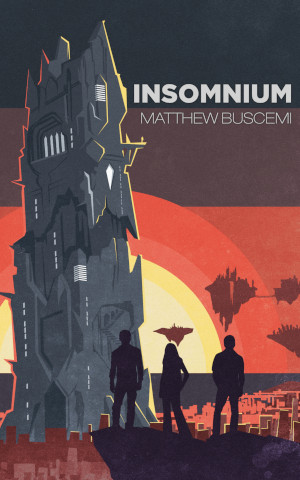On Consistency and Dedication; Or, the History of Matt Buscemi's Powerlifting
Friday, July 2, 2021 at 6:00am
Sports are important part of my life. I go back and forth about how much to share about it on this blog for two reasons. The first is the much better reason of keeping the blog tightly focused on reading and writing literature. The second is that the topic is fraught for me. Kal’s experiences on the swim team on Irth in Voyage Embarkation and Rev’s memories of the baseball team from Insomnium spring readily to mind. However, the more I think about this second point, the more I think that it is actually a reason to discuss the topic openly. It will feature prominently in my novel When the Gods Wish to Punish, currently still an in-progress draft.
To the first point, I discovered last year that there are, in fact, two overlaps between writing and the sport I’m most passionate about—and that was both in terms of the development of discipline and also incremental improvement. Powerlifting even has a technical term for the latter: “progressive overload.”
And so, I’ve had the idea to write up my history with regards to the sport. I hope to give readers of this blog a sense that things they think are impossible or even wildly difficult are in fact not out of reach. It does take sustained effort over a long period of time and developing both a sense of contentment with small improvements and resilience when confronted with unexpected setbacks. However, with such an attitude, great things are possible, whether that is with regards to becoming an author of multiple novel-length works, swimming a mile, deadlifting twice your bodyweight, or any other goal you might set out to achieve.
Prelude (birth - 2016)
The sport of powerlifting involves the performance of three particular exercises: the back squat, the bench press, and the deadlift. An athlete will, for a competition, get three attempts at performing one repetition of each of these exercises. The amount of weight pushed or pulled in each lift is added together to form a number called a “powerlifting total,” a rough gauge of strength.
I learned how to bench press in high school during a strength training class, but no one had ever taught me squats or deadlifts, and for a very long time I was afraid of performing these movements. “Isn’t that weighted bar going to crush me into the floor?” “Don’t heavy deadlifts destroy your back?” Such thoughts ran through my mind. I also didn’t know what Olympic weightlifting or powerlifting even were. All I knew was that I liked lifting weights.
Throughout the aughts, I was busy with various life endeavors such as graduate school, establishing my career, and later, in the early twenty-tens, writing novels. I lifted on and off, but I only did machine isolation exercises, which I could confidently perform without hurting myself.
Learning the Lifts (2016 - 2018)
In 2016, I acquired an app called Strong, which I still use to this day. It is from its records that I am gleaning much of this period’s history, as it is now hazy in my memory.
My first recorded Strong workout is on April 24, 2016, and on the next day, I recorded my first ever front squat at 45 lb (just the barbell; no plates). Sometime in 2016, I decided to get a trainer, and I asked him to teach me both the squat and the deadlift, because I wanted to do those exercises without hurting myself. My trainer started me out with the front squat and eventually taught me the back squat and the deadlift as well.
However, even though I had learned the lifts, I didn’t know how to do them well. As I added weight to my squats, I started sinking less and less, prompting my trainer at one point to remark that I needed to go much, much deeper. I didn’t even realize that had happened. I also had a number of problems keeping my form intact as the deadlift weight increased (more on that later).
Even after learning the lifts in 2016, I struggled constantly with running into a “wall.” My Strong record for this period on back squat, bench press, and deadlift is pretty telling. For each exercise, there are a smattering of routines performed over a week or two, which top out at the same weights each time, followed by weeks and weeks of inactivity.
- Squat: 150
- Bench Press: 160
- Deadlift: 210
I would hit those weights, perhaps do them a bunch of times, try a weight slightly heavier, and then fail. Every single time.
During this period, I told myself a lot of nonsense, like that I just wasn’t built for lifting weights and I wasn’t gifted at it so why even bother, and all kinds of really toxic self-talk. I didn’t believe I could make any significant progress. In fact, two elements of my behavior were sabotaging me. The first was taking enormous amounts of time off. The second was moving up to my max too quickly.
StrongLifts 5x5 (Jun 2018 - Apr 2019)
For a brief couple of months in 2018, I was not logging my workouts in Strong. Instead, I can open up my StrongLifts app and still see my first ever routine of StrongLifts 5x5 on June 25, 2018. This routine would be my training regimen for nearly a year.
That June, I had happened to lament to a work colleague about how I would get frustrated with heavy compound exercises like the squat, bench, and deadlift. By that time, I had come to notice that every time I hit my heaviest weights, I would plateau and make no further progress. I could see what other guys my height and body type were lifting and that my “wall” weights were well below what should have been possible for me to achieve. I then added as a kind of joke, “I suppose it doesn’t help that I quit going to the gym for weeks at a time, huh?” To which, my colleague responded, quite seriously, “Yeah. You should probably stop doing that.”
In that moment, for whatever reason, I decided not to quit anymore. I would stay consistent in my training. Discipline had been established.
However, there remained the problem of what to do if not the failing strategy I had maintained up to that point. I did a Google search for something to the effect of “how to make progress with compound lifts” and StrongLifts 5x5 popped up.
The style and tone of the website was geared toward me and my goals at the time. The message of the website is that you can make progress, and that progress is quite simple, if only you do two things: 1) provide your body the right amount of rest, 2) only move up weight very slowly. So instead of going from 100-150 on squat over the course of week and getting angry when I couldn’t get past 150, I was to start with the lowest weight possible, the empty bar at 45 lb, and only add 5 lb each time I lifted. Also, I was only to work out every other day instead of every day.
I remember starting StrongLifts and thinking it would be another story for work. “Oh, hey, you know one time I tried this goofy routine that wanted me to make progress by starting with really, really low weight. Well, I still topped out at 150 lb back squat and failed again. Go figure.”
Instead, something amazing happened. I remember getting to 135 lb on back squat (July 28) and thinking that the squats were still quite easy. Well, that was about to change any day now, right?
Then, I did 140. It was still easy. Then 145 was easy. Then 150 was easy (August 4).
On August 6, when I successfully squatted five sets of five reps of 155 lb, I was both ecstatic and converted to the principle of gradual progressive overload.
This is also exactly the day when I started duplicating my StrongLifts exercises in the Strong app, so that I would have them alongside my other workouts historically.
I proceeded to follow StrongLifts to the letter until April of 2019, at which point I had achieved the following numbers:
- Squat: 225
- Bench Press: 177.5
- Deadlift: 260
This represented an enormous increase over my previous plateau weights in the cases of squat and deadlift. StrongLifts also introduced me to the ancillary compound movements of the overhead press and the pendlay row.
However, in late 2018 and 2019, I was reading more and more about different routines and approaches to progressive overload. One repeated, common critique of StrongLifts was that, while it’s good and simple, which is a boon for helping someone like me overcome a plateau and build confidence, its method of dropping weight and resetting when you do hit another wall (and there will always be new walls for you to discover when you overcome old ones), is not optimal for progression after a certain point.
I did a ton of research into lifting routines, and by early 2019, I had discovered the one I wanted to try next.
nSuns (Apr 2019 - Sept 2019)
StrongLifts is a direct linear progression. You do five sets of five reps of a weight, and if it goes well, you try more weight next time. The method is simple, but it also means you will eventually run into another wall, and you will have to adapt your training.
nSuns is also a linear progression, but with a lot more nuance. Instead of just doing “a weight” for so many total reps, you enter a “training max” for each exercise, and a spreadsheet filled with formulae will calculate from it a week’s worth of routines. Some of the sets will be easy, some will be moderate, and one set in particular will be very hard. That hardest set is an amount of weight equal to 95% of your training max, and how well you do determines whether or not the training max goes up in the following week. Mixing easy, moderate, and hard training like this actually makes increasing your strength easier.
During this period, I followed nSuns rigorously, and once again, saw pretty good results. By September of 2019:
- Squat: 265
- Bench Press: 215
- Deadlift: 330
There was also something else of note that happened during this period. I am a very early riser and prefer to work out at 2-3 am. Naturally, I see very few other people in the gym at that time. I’ve come to know the cleaning staff very well, a few other regular early risers, and occasionally I do see others, who pop in for a late night/early morning lift.
One day, a morning newbie saw me doing nSuns and worked up the courage to ask me, “Are you a powerlifter?”
I remember being unsure how to respond. I didn’t know what a powerlifter was, so I decided to respond with “no,” but then proceeded to briefly explain about StrongLifts and nSuns and why I chose them.
When I got home that day, I used Google to teach myself what a powerlifter was. After I’d learned, I realized that the correct answer had in fact been “not yet.”
But all that was about to get thrown up into the air. Shortly after reaching that 330 lb deadlift, something unfortunate happened.
Deadlift Injury & Recovery (Sept 2019 - March 2020)
To this day, I have never injured myself pushing or pulling heavy weight. I always do it when lifting light weights or when doing something unrelated. About a week after hitting that awesome 330 lb deadlift single, on September 3, I was doing some stupidly easy deadlift weight (the exact number isn’t recorded as I canceled out that routine) and something very, very painful happened in my lower back. I dropped the weight immediately and called my husband, who came to the gym (yes, at 3 am) and helped me get home.
I spent the entire day in bed, and was only barely mobile the next. For weeks afterward, many simple movements were difficult and caused pain: sitting down, putting on socks, etc. It was a very humbling experience. My husband was wonderful throughout it.
Fortunately, I have physical therapy coverage through my health insurance, and I was able to sign up right away. On the first day, I asked my PT if I would lift heavy ever again, and he gave me one of those looks and told me I would.
However, in a complete and total blow to my ego, he made me do the unimaginable a few weeks later. When it finally came time for me to go back to lifting, which Strong tells me was on September 22, my PT insisted I set the weight on all lifts back to as low as they could possibly go. It felt like all progress I had made since I had discovered StrongLifts in June 2018 had been erased. I was starting again from where I had back then: the empty bar.
However, I had no choice. If I ever wanted to make any kind of progress ever again, I was to follow my doctor’s orders. And so I did. From September 2019 to January 2020, I performed a heavily modified form of nSuns that still used a training max but was much more StrongLifts-like in the reduced distance between the easiest and hardest lifts.
I started seeking out more materials on how to make my own routines and discovered that there were principles to it. The experience taught me that I could change the routines myself and I didn’t need to blindly follow someone else’s plan. I gained a lot of confidence doing so.
In January 2020, my PT gave me a clean bill of health and told me I was free to do whatever progression scheme I wanted. My back pain had diminished to near nothing, and I could at least see the gap between my pre-injury numbers and my current as perhaps someday closable:
- Squat: 215
- Bench Press: 185
- Deadlift: 240
But then, of course, we all know what happened in 2020…
The Great Pandemic Pause (Mar 2020 - Sept 2020)
In March 2020, I found myself quite suddenly and unexpectedly with no gym access whatsoever. I went to Google with a new line of questioning: how do I maintain my strength with no rack, barbell, or plates? The answer: Maybe high volume kettlebell training? Maybe.
I purchased a set of kettlebells and proceeded to try to replicate my powerlifting exercises with them. I despised each and every minute of doing this, but I forced myself to, because I did not want to lose the progress I had made toward getting back to where I had been in September 2019.
During this period, I also began devouring information online about powerlifting, what the rules were, what the leagues were, what kind of gyms powerlifters typically trained at, and so on.
Remember that, during these months of the pandemic, we had no idea if we were ever going to be free of it. The efficacy data on Pfizer and Moderna didn’t come out until November. I remember thinking, what if I don’t ever get to compete? What if I’m stuck doing these awful kettlebell exercises for years? I became determined that, when things opened up, I was going to pursue this. Really pursue it.
At the height of my kettlebell exercises, I did nine sets of 32x50 lb kettlebell goblet squats, nine sets of 48x45 lb kettlebell floor presses, and nine sets of 48x50 lb kettlebell deadlifts. I never, ever want to do such exercises again.
The Ventilated Gym and the Power Cave (Sept 2020 - Apr 2021)
In September 2020, Washington State had partially reopened. I bought sports masks and found myself a gym with really good ventilation (windows that opened). I tested my maxes and was horrified at the results: squats got difficult at 160 lb, bench press at 145, deadlift at 175. It was an enormous emotional blow. All of those months with that horrible kettlebell volume work, and it hadn’t even preserved my strength.
I used my rage to drive my progress. Over the course of September and October, I dedicated myself to a near immaculate eating, sleeping, and lifting regimen. I discovered that my strength returned very, very quickly (I have since read that muscle memory is a powerful force, not just with regard to small actions, but with regards to big, complex actions like heavy compounds, too).
By mid-November 2020, I was back at:
- Squat: 235
- Bench Press: 200
- Deadlift: 250
In the case of squat and bench, I was so terrifically close to my September 2019 numbers. In the case of deadlift, I was beginning to think that maybe I wasn’t completely broken for life after all.
Then the Washington State governor shut down gyms again. Not everything. Literally just gyms and bars. Seriously? The first lockdown had felt fair—I had been doing my part to curb the pandemic along with everyone else. But this new restriction felt as though literally everyone else got to do whatever they wanted except for me. The people who frequented bars could still easily buy alcohol and congregate in their homes. I was incensed, which I alluded to in this post.
I solved this problem by renting a space and building out a home gym, which I proceeded to refer to as “the power cave.” On November 24, a little over a week after the gyms had been shut down, I was back to lifting again. I did a week of seeing where my maxes were, was pleasantly surprised that I hadn’t lost any strength, and got right to it.
I blew past my September 2019 all-time maxes before too much longer. By mid-December, I’d surpassed my old records on squat and bench, and on Christmas Eve 2020, I surpassed my old deadlift record:
- Squat: 285
- Bench Press: 218
- Deadlift: 340
Moving into 2021, the records kept coming. By the end of January, I’d blown away 2020’s numbers as well:
- Squat: 320
- Bench Press: 233
- Deadlift: 385
I had also exhausted myself in the progress.
I took a few weeks off to recharge, and came back at it in February with slightly reduced maxes. This was also when I found out that Washington State Powerlifting competitions were getting going again. I decided to sign up for the next, which was in April.
I made really good progress toward getting back to my previous maxes for about a month… and then strained my left latissimus dorsi. I took a whole week off a lifting, thinking, maybe, just maybe, if I left it alone I wouldn’t lose too much strength and I would be able to come back solid and still compete.
After that week, I discovered that, while I could perform all of the movements of the lifts without any pain, the act of merely putting on a weight lifting belt aggravated my strained muscle. At that point, I decided not to try to push myself to do the competition, as that would probably just lead to further injury.
I continued lifting without the belt for a month. When April rolled around, I was able to get my Pfizer shot. And that opened up a world of possibilities.
The Return to “Normal” (Apr 2021 - present)
Before too much longer, I was able to go back to my twenty-four hour access gym. It was around this time I tried my belt again and discovered that my lat had fully healed.
With that out of the way and my numbers trending upward again, I decided to start looking at upcoming competitions. The next one turned out to be in May, which was far too soon for me to compete in, so I decided to volunteer at it instead. This turned out to be a great decision. It effectively eliminated my fear of not knowing how anything worked and messing up something that was obvious to everyone else. I got to see how the whole event was run from the inside. Super helpful.
I surpassed my January numbers for the first time on June 3, hitting a new deadlift max, which I followed on June 4 with bench press and squat:
- Squat: 330
- Bench Press: 240
- Deadlift: 405
This past weekend, despite the blazing torpor that descended upon Seattle, I forced myself into the gym, where I achieved my new all time maxes:
- Squat: 345
- Bench Press: 245
- Deadlift: 410
This brought my powerlifting total to exactly 1,000 lb.
Epilogue
To summarize:
- June 2018: squat 150, bench press 160, deadlift 210; PL total 520
- 2019: major injury
- 2020: global pandemic shuts down Washington State for six months and causes me further training disruptions for months afterward
- 2021: minor injury
- June 2021: squat 345, bench press 245, deadlift 410; PL total 1,000
Consistency and dedication will always win out over whatever life throws at you. If you want to write that book but don’t know where to start, write a short story. Write a scene. Write something. Anything. It’s a building block. Create it, and worry about the next block when you’re done with the first. Yes, something will go wrong with your first draft. Something went majorly wrong with my first novel series in the middle of book two out of five. It doesn’t matter.
Just keep writing. Or lifting. Or whatever else you’re passionate about. Just, whatever you do, don’t quit. And certainly don’t tell yourself that you can’t or that it’s not worth trying. You will never know what you are actually capable of until you try.









